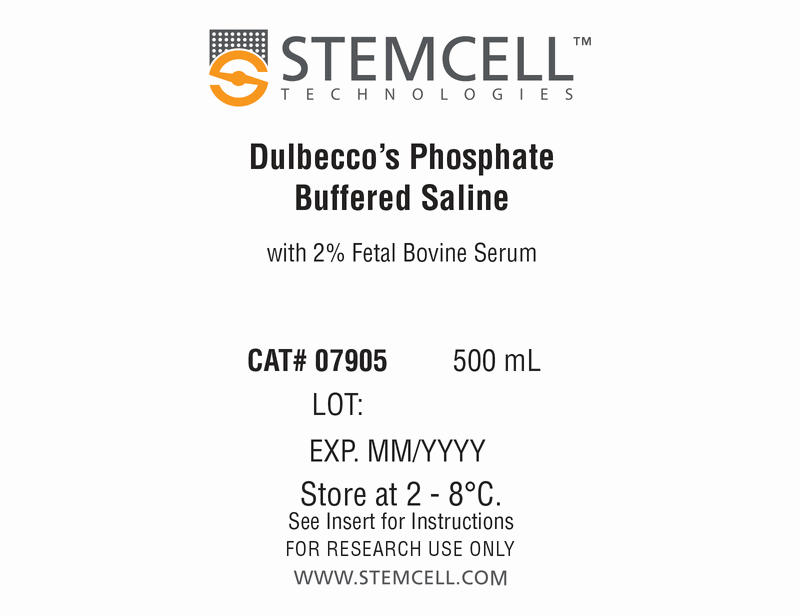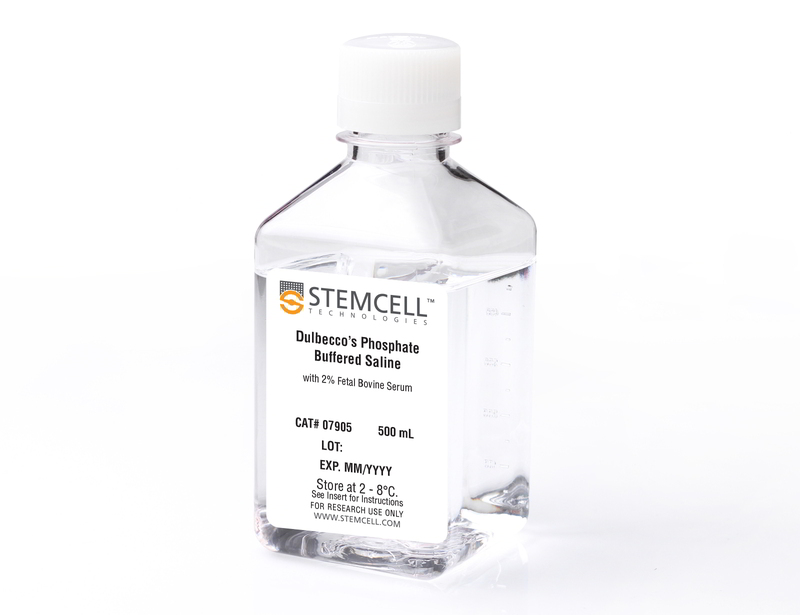概要
Dulbecco's Phosphate Buffered Saline with 2% Fetal Bovine Serum is recommended for use as a buffer to dilute or wash nucleated cells.
技术资料
| Document Type | 产品名称 | Catalog # | Lot # | 语言 |
|---|---|---|---|---|
| Product Information Sheet | Dulbecco's Phosphate Buffered Saline with 2% Fetal Bovine Serum | 07905 | All | English |
| Safety Data Sheet | Dulbecco's Phosphate Buffered Saline with 2% Fetal Bovine Serum | 07905 | All | English |
数据及文献
Publications (2)
Methods in molecular biology (Clifton, N.J.) 2011 JAN
Functional assays for human embryonic stem cell pluripotency.
Abstract
Abstract
Realizing the potential that human embryonic stem cells (hESCs) hold, both for the advancement of biomedical science and the development of new treatments for many human disorders, will be greatly facilitated by the introduction of standardized methods for assessing and altering the biological properties of these cells. The 7-day in vitro alkaline phosphatase colony-forming cell (AP(+)-CFC) assay currently offers the most sensitive and specific method to quantify the frequency of undifferentiated cells present in a culture. In this regard, it is superior to any phenotypic assessment protocol. The AP(+)-CFC assay, thus, provides a valuable tool for monitoring the quality of hESC cultures, and also for evaluating quantitative changes in pluripotent cell numbers following manipulations that may affect the self-renewal and differentiation properties of the treated cells. Two other methods routinely used to evaluate hESC pluripotency involve either culturing the cells under conditions that promote the formation of nonadherent differentiating cell aggregates (termed embryoid bodies), or transplanting the cells into immunodeficient mice to obtain teratomas containing differentiated cells representative of endoderm, mesoderm, and ectoderm lineages.
Experimental hematology 2011 AUG
Retinoblastoma-binding proteins 4 and 9 are important for human pluripotent stem cell maintenance.
Abstract
Abstract
OBJECTIVE: The molecular mechanisms that maintain human pluripotent stem (PS) cells are not completely understood. Here we sought to identify new candidate PS cell regulators to facilitate future improvements in their generation, expansion, and differentiation. MATERIALS AND METHODS: We used bioinformatic analyses of multiple serial-analysis-of-gene-expression libraries (generated from human PS cells and their differentiated derivatives), together with small interfering RNA (siRNA) screening to identify candidate pluripotency regulators. Validation of candidate regulators involved promoter analyses, Affymetrix profiling, real-time PCR, and immunoprecipitation. RESULTS: Promoter analysis of genes differentially expressed across multiple serial-analysis-of-gene-expression libraries identified E2F motifs in the promoters of many PS cell-specific genes (e.g., POU5F1, NANOG, SOX2, FOXD3). siRNA analyses identified two retinoblastoma binding proteins (RBBP4, RBBP9) as required for maintenance of multiple human PS cell types. Both RBBPs were bound to RB in human PS cells, and E2F motifs were present in the promoters of genes whose expression was altered by decreasing RBBP4 and RBBP9 expression. Affymetrix and real-time PCR studies of siRNA-treated human PS cells showed that reduced RBBP4 or RBBP9 expression concomitantly decreased expression of POU5F1, NANOG, SOX2, and/or FOXD3 plus certain cell cycle genes (e.g., CCNA2, CCNB1), while increasing expression of genes involved in organogenesis (particularly neurogenesis). CONCLUSIONS: These results reveal new candidate positive regulators of human PS cells, providing evidence of their ability to regulate expression of pluripotency, cell cycle, and differentiation genes in human PS cells. These data provide valuable new leads for further elucidating mechanisms of human pluripotency.

 网站首页
网站首页



